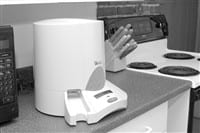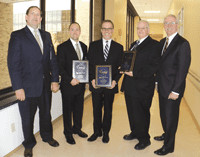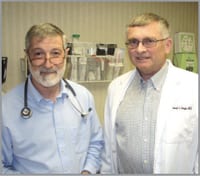Phoning It In Telehealth Technology Moves To The Mainstream, Abandons Futuristic Image
Joanne Peterson calls the use of telehealth in managing patient care at home “a very Jetson kind of thing.”
But unlike flying cars and robot maids, telehealth is right here, right now. The equipment that makes home care more efficient – patient stations usually no larger than a toaster that use Web-cams, modems, and standard phone lines to monitor weight, heart rate, blood oxygen levels, blood pressure, and other variables – has actually been used for decades, but is now entering a period of acceptance among patients of all ages and backgrounds, with a diverse set of medical concerns, that find the systems helpful, convenient, and above all, easy to use.
Peterson, program development coordinator for the Baystate Visiting Nurse Association and Hospice (BVNAH), said that although she still finds telehealth equipment to be an increasingly common aspect of home care and of nursing in general, the patient stations and other equipment such as automated medication dispensers still hold a certain ‘wow’ factor.
“Telehealth started 30 to 40 years ago as a military application,” she explained, “and it has also been used extensively by NASA. So essentially, science that astronauts have used is also being used right here in Western Mass., to help treat our patients.”
And not only is telehealth becoming more prevalent, it is also gaining acceptance from health care professionals and their patients. In fact, several VNAs and private home care groups are now using telehealth locally to augment the medical care of their patients.
“From the office, a nurse can make a personal visit in addition to visiting in person,” she said. “The nurse can communicate directly with the patient over the real-time tele-video connection, and perform a visual assessment.”
Or, Peterson explained, a nurse can also monitor weight, heart rate, and other vital signs using the patient station, which includes a blood pressure cuff and scale, among other equipment.
“With video tele-monitoring or without, the systems are efficient and user-friendly,” she said, returning to the idea that because people are more technologically smart than ever before, more and more people are accepting tele-health as a valid treatment option.
“In 1998, we tried a telehealth initiative similar to what we have now, and it didn’t fly,” she said. “We thought we were tech-savvy back then, but when you think back, you realize most of us didn’t even have cell phones yet.”
But now, it’s 2005, Peterson said, and the technology of health care is moving right along with technological advances in all other walks of life.
“When you think about how much technology everyday people encounter on a regular basis, you realize that learning how to operate a telehealth system isn’t a big cognitive leap,” she explained. “From cell phones to home computers to ATMs, technology is a huge part of our culture today. When I tell an elderly patient, for instance, that the telehealth system in their home will be just as easy to use as opening a picture of their grandchild on their computer, the fear goes away.”
“The People on the Other End”
Peterson explained that although the technology does not replace the work of a registered nurse and a team of physicians, it does improve the delivery of care to patients using the systems by making routine check-ups more convenient, while maintaining accuracy.
She added that because the equipment necessary to conduct assessments is located right in the patient’s home, patients can be monitored more frequently, allowing for more opportunities to identify potential problems.
And BVNAH patients using telehealth are echoing Peterson’s comments on the ease of the systems. Alan Guimaraes, a West Springfield resident who uses the telehealth equipment in his home once a day to monitor his heart rate, breathing function, and blood pressure, in addition to daily checks of his weight and blood sugar, said it only took him about two days to get used to the new system, and he voiced his utmost confidence in the technology.
“It’s a wonderful system,” he said. “I only need to use it in the morning for 15 to 20 minutes, and I’m all done. I definitely think a method like this has enormous potential, and it makes life a little easier for me and for the people on the other end; the nurses don’t have to come out quite so much.”
Guimaraes added that if the system reads any abnormalities, his cardiologist is alerted immediately, giving him some extra peace of mind.
“It’s an asset for everyone, because it keeps the cardiologist apprised of what is going on,” he said.
Peterson said that constant feed of information is one of the biggest advantages of telehealth as it becomes more assimilated into the practice of home care.
“Things like the automated medication dispenser don’t just make taking pills easier,” she said. “It becomes a quality-of-life at home issue. Medication management is one of the key reasons people have to leave their homes to enter facilities, and if someone can stay at home a little longer, that’s a big deal.”
Telehealth can also curb visits to the hospital, by detecting problems before a patient might, Peterson said.
Guimaraes was quick to note that the role of his health care team has not been forgotten with the addition of state-of-the-art equipment. He said while a telehealth system makes monitoring his health that much easier, it’s the nurses and physicians who administer his care, not the machines.
“It’s a wonderful system because the people on the other end are so knowledgeable,” he said. “They see things more clearly than I do.”
A New Age of Nursing
Peterson agreed, noting that while she feels telehealth is improving health care delivery, it will likely never replace human interaction, virtual or otherwise, as the best type of care for everyone. She added that during the early years of telehealth, she was skeptical of its effectiveness in treating patients.
“As a nurse, I was wary of something that seemed like an attempt at replacing skilled nursing care,” she said. “But now I have grown to embrace it, and realize that telehealth isn’t a replacement, but rather a supplement.”
Jane Jetson would agree.




Comments are closed.